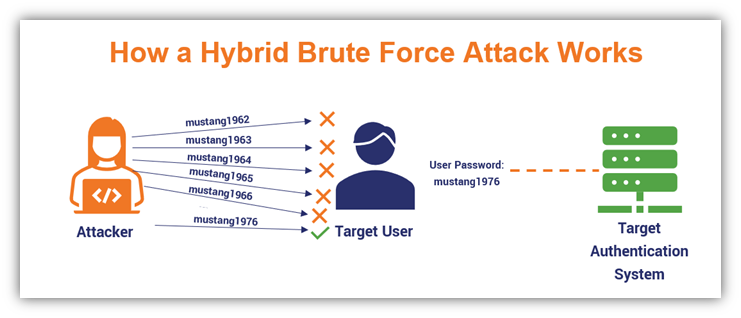A brute force attack is a method used by attackers to gain unauthorized access to a system, encrypted data, or a protected resource by systematically trying all possible combinations of passwords, encryption keys, or other authentication credentials until the correct one is found. The working principle of a brute force attack involves the following steps:
-
Selection of Target:
- Attackers choose a target system or resource that requires authentication, such as a login page, encrypted file, or network device.
-
Identification of Authentication Parameters:
- Attackers identify the parameters that require authentication, such as usernames and passwords for a login page or an encryption key for an encrypted file.
-
Generation of Credentials:
- Attackers create a list of possible credentials to test. For example, if the target is a password-protected account, the attacker may generate a list of common passwords, dictionary words, or character combinations.
-
Systematic Testing:
- The attacker systematically tests each credential from the generated list by attempting to access the target system or resource. This testing can be automated using software tools designed for brute force attacks.
-
Repeated Attempts:
- The process is repeated with different credentials until the correct combination is found. Brute force attacks are exhaustive and may take a significant amount of time, especially if the password or key is complex and lengthy.
-
Success and Unauthorized Access:
- Once the attacker discovers the correct credential combination, they gain unauthorized access to the system or resource. This access can be exploited for various malicious purposes, such as stealing sensitive data, conducting further attacks, or causing disruption.
Mitigation and Prevention:
- To prevent and mitigate brute force attacks, organizations and individuals can implement several security measures, including:
- Enforcing strong password policies.
- Implementing account lockout policies after a certain number of failed login attempts.
- Using multi-factor authentication (MFA) to add an extra layer of security.
- Monitoring and logging login attempts for suspicious activities.
- Employing intrusion detection and prevention systems.
It's important for individuals and organizations to be aware of the risks associated with brute force attacks and take proactive steps to secure their systems and sensitive information. Regularly updating passwords, using strong authentication methods, and staying informed about cybersecurity best practices are essential for maintaining a secure digital environment.
Thank you.

